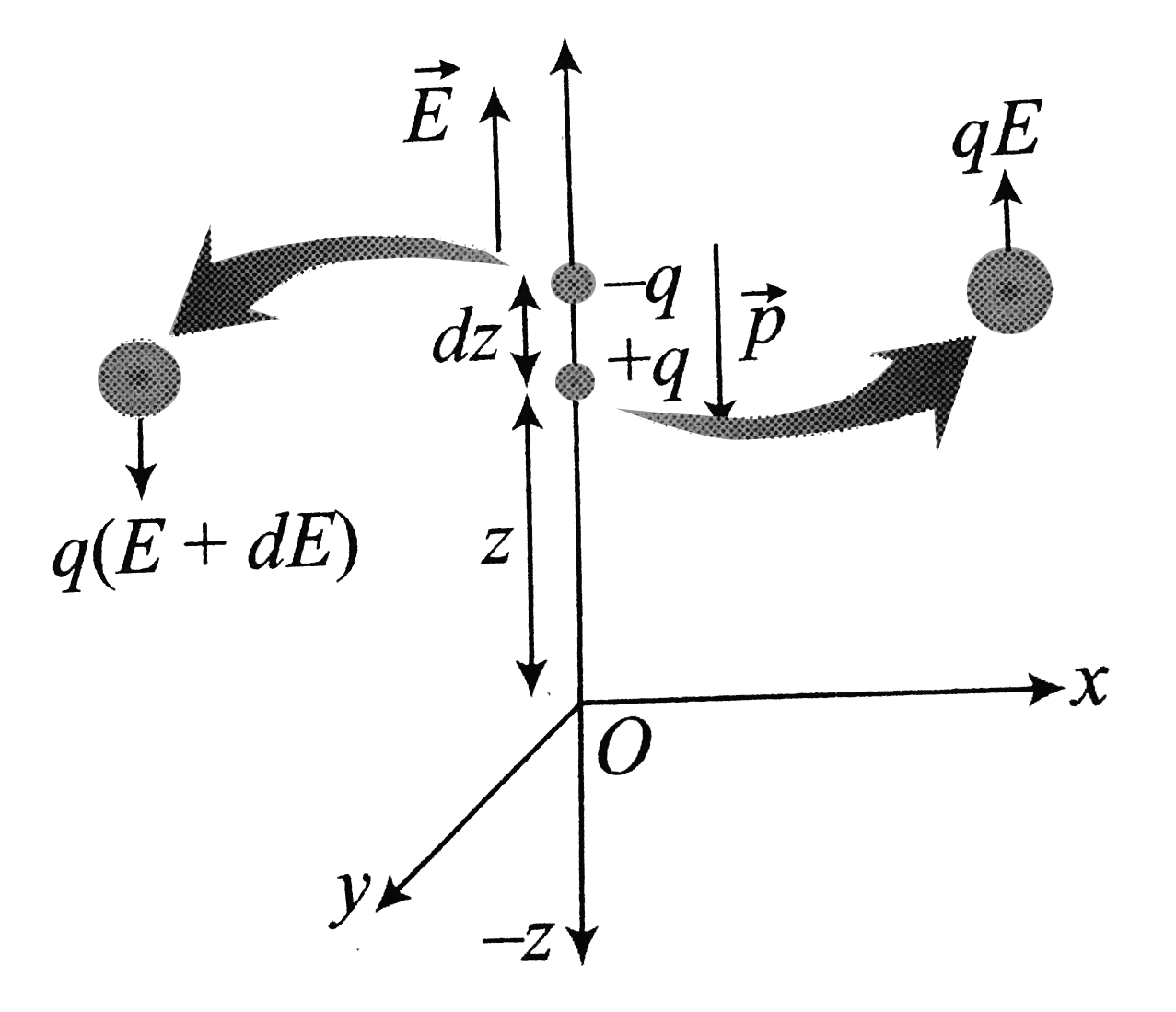In a certain region of space, electric field is along the z-direction throughout. The magnitude of electric field is , however, not constant but increases uniformly along the positive z-direction. At the rate of 105NC−1m−1 . What are the force and torque experienced by system having a total dipole moment equal to 10−7Cm in the negative z-direction?
10−4N along +z-direction
10−4N along −z-direction
10−2N along −z-direction
10−2N along +z-direction
The correct Answer is:c
Net force on dipole Fnet=qdE
Fnet=(qdz)(dEdZ)=p(dEdZ)
=10−7×(105)=10−2N along −z-direction

Topper's Solved these Questions
- BOOK - A2ZCHAPTER - ELECTRIC CHARGE, FIELD & FLUXEXERCISE - Assertion Reason7videos
ELECTRIC CHARGE, FIELD & FLUX
- BOOK - A2ZCHAPTER - ELECTRIC CHARGE, FIELD & FLUXEXERCISE - Section D - Chapter End Test29videos
ELECTRIC CHARGE, FIELD & FLUX
- BOOK - A2ZCHAPTER - ELECTRIC CHARGE, FIELD & FLUXEXERCISE - AIPMTNEET Questions24videos
ELECTRIC CHARGE, FIELD & FLUX
- BOOK - A2ZCHAPTER - DUAL NATURE OF RADIATION AND MATTEREXERCISE - Section D - Chapter End Test30videos
DUAL NATURE OF RADIATION AND MATTER
- BOOK - A2ZCHAPTER - ELECTRIC POTENTIAL & CAPACITANCEEXERCISE - Section D - Chapter End Test29videos
ELECTRIC POTENTIAL & CAPACITANCE
Similar Questions
In a certain rigion of space, electric field is along the z-direction throughout. The magnitude of electric field is , however, not constant but increases uniformaly along the positive z-direction, at the rate of 105NC−1 per metre, What are the force and torque experienced by a system having a total dopole moment equal to 10−7 C-m in the negative z-direction?
View SolutionA square loop of side 12 cm with its sides parallel to X and Y axes is moved with a velocity of 8 cm s−1 in the positive x-direction in an environment containing a magnetic field in the positive z-direction. The field is neither uniform in space nor constant in time. It has a gradient of 10−3Tcm−1 along the negative x-direction (that is it increases by 10−3Tcm−1 as one moves in the negative x-direction), and it is decreasing in time at the rate of 10−3Ts−1. Determine the direction and magnitude of the induced current in the loop if its resistance is 4.50mΩ.
View Solution
Knowledge Check
- Question 1 - Select One
In a certain 0.1m3 of space, electric potential is found to be 5 V throughout. What is the electric field in this region ?
A50V/mBzeroC0.5V/mDNone of these - Question 2 - Select One
An electromagnetic wave is traveling in the positive x direction with its electric filed along the z axis and its magnetic field along the y axis . The fields are related by
A∂E∂x=μ0ε0∂B∂xB∂E∂x=μ0ε0∂B∂tC∂B∂x=μ0ε0∂E∂tD∂B∂x=μ0ε0∂E∂t - Question 3 - Select One
A proton is moving with a velocity of 5×105m/s along the Y-direction. It is acted upon by an electric field of intensity 105 V/m along the X-direction and a magnetic field of 1Wb/m2 along the Z-direction. Then the Lorentz force on the particle is :
AzeroB8.0×10−4 N along X-axisC9.6×10−14 along Z-axisD9.6×10−14 along X-axis
A square loop of side 12 cm with its sides parallel to X and Y axes is moved with a velocity of 8 cm s−1 in the positive x-direction in an environment containing a magnetic field in the positive z-direction. The field is neither uniform in space nor constant in time. It has a gradient of 10−3Tcm−1 along the negative x-direction (that is it increases by 10−3Tcm−1as one moves in the negative x-direction), and it is decreasing in time at the rate of 10−3Ts−1. Determine the direction and magnitude of the induced current in the loop if its resistance is 4.50 mΩ.
View SolutionA plane electromagnetic wave travels in vacuum along z-direction. What can you say about the direction of electric and magnetic field vectors ?
View SolutionA plane electromagnetic wave travels in vacuum along z-direction. What can you say about the direction of electric and magnetic field vectors?
View SolutionThe position vector →r of a particle points along the positive direction of a z axis. If the torque on the particle is (a) zero, (b) in the negative direction of x, and ( c) in the negative direction of y, in what direction is the force causing the torque?
View SolutionThe electric potential in a region is given by the relation V(x)=4+5x2. If a dipole is placed at position (-1,0) with dipole moment →P pointing along positive y-direction, then
View Solution

